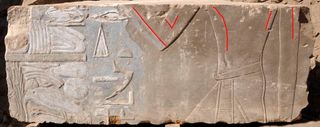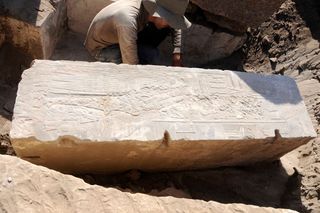Building for Egypt's First Female Pharaoh Discovered

Ancient stone blocks depicting Queen Hatshepsut have been discovered on Egypt's Elephantine Island, providing insights into the early years of her reign, Egypt's Ministry of Antiquities announced this week. The blocks may have been part of a building that served as a way station for an ancient Egyptian deity.
On several of the blocks, Queen Hatshepsut was represented as a woman, according to the Ministry, suggesting that the blocks and building it came from were erected during the early part of the first female pharaoh's reign, which lasted from 1473 B.C. to 1458 B.C. Later in her reign, the queen was depicted as a male.
Mentions of Queen Hatshepsut were erased and monuments bearing her image were defaced after her death, and her female figure was replaced with images of a male king: her deceased husband Thutmose II. It is believed that her co-ruler and stepson/nephew Thutmose III ordered the change. [Photos: The Beautiful Sarcophagus of an Egypt Pharaoh]
It was unusual for a woman to become pharaoh of Egypt. As Egyptologist Ian Shaw noted in his book "Exploring Ancient Egypt" (Oxford University Press, 2003), "In the history of Egypt during the dynastic period (3000 to 332 B.C.) there were only two or three women who managed to rule as pharaohs, rather than wielding power as the 'great wife' of a male king."

And she was a builder: In his National Geographic feature on Hatshepsut "The King Herself," Chip Brown wrote about her legacy, and said she was "one of the greatest builders in one of the greatest Egyptian dynasties." During her reign, Hatshepsut erected and renovated many temples and shrines to the gods.
In fact, the newfound blocks likely were part of a previously unknown building of Queen Hatshepsut that was discovered this year by the German Archaeological Institute, said Mahmoud Afify, head of the Ancient Egyptian Antiquities Sector, in the Ministry of Antiquities' statement on Facebook. In previous excavation seasons at the same site, members of the Swiss Institute also discovered some blocks that may have come from the same building.
The building would have served as a way station for the festival barque of the god Khnum, said Felix Arnold, field director of the Elephantine Island mission. In ancient Egypt, "barques," or sacred boats, were used to help carry the dead to the afterlife.
Sign up for the Live Science daily newsletter now
Get the world’s most fascinating discoveries delivered straight to your inbox.

Based on the discoveries thus far, in the same statement, the Ministry of Antiquities described the building's construction as a chamber for the barque of the god Khnum, which is surrounded by pillars on all four sides.
"On the pillars are representations of several versions of the god Khnum, as well as other gods, such as Imi-peref 'He-who-is-in-his-house,' Nebet-menit 'Lady-of-the-mooring-post' and Min-Amun of Nubia," according to the Ministry statement on Facebook. "The building thus not only adds to our knowledge of the history of Queen Hatshepsut, but also to our understanding of the religious beliefs current on the Island of Elephantine during her reign."
Follow Live Science @livescience, Facebook & Google+. Original article on Live Science.

